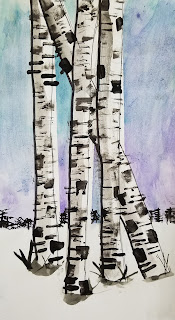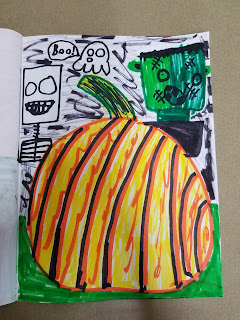2 Class Periods
 |
| Winter Birch Trees, Fourth Grade Art Lesson |
This year I put a new spin on my Birch Tree lesson. To view the original lesson click here: Birch Tree Landscape. I feel that my students did fairly well with the changes I made for this lesson, although it was bit more challenging for some of my students then the previous Birch Tree Landscape lesson I did the year before.
Day 1:
Students used painters tape to create the trees which then set the paper up for a resist. In addition to the tape, students also blocked the bottom part of their paper with heavy tagboard to keep the area white for the snow on the ground.
 |
| Adding tape to create tree resist. |
 |
| Adding tagboard to create the snow on the ground resist. |
Students next painted the sky. Once the sky was painted, the tagboard was removed. Students used watered down black tempera to create shadows on the bottom of the tape (this is where the tree will be growing from the ground).
 |
| Adding the shadows near the bottom of the tree after the tagboard is removed. Notice tape for the trees is still in place. |
 |
| Removing the tape that represents the tree after the shadows on the snow have been added. |
Next, students carefully removed the painter's tape and set pieces on drying rack to dry.
 |
| What project looks like after day 1. |
Day 2:
Student began day 2 by taking a ruler and a pencil and outlining the outside of their trees. Students that chose to have trees cross in their compositions had to think about which tree was in front. To help them I had them look at the bottom of their paper to see which trees were longer, those would be the ones closest to them.
After the trees were outlined with a pencil, I had students outline one side of the tree with a thick black sharpie marker. We had a discussion about shadows and highlight. After they picked the side of the tree that would be outline with the thick black sharpie, students used a light black tempera paint wash to paint a shadow on that side of the tree.
I next demonstrated to students how to add some details to their background such as trees and to their foreground like blades of grass popping out by the trunk of the tree.
Using liquid black tempera paint and little scraps of tagboard I demonstrated to students how they could scrape and add lines into their trees to create the Birch tree look.
Other things that could be added might be a fence in the background or snow falling down. Maybe, next year I will expand once again on this lesson.
Examples of Student Work:



















































